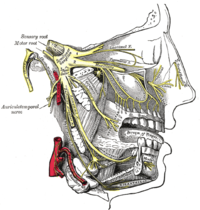
Photo from wikipedia
Background: Percutaneous radiofrequency thermocoagulation (PRT) is used to treat trigeminal neuralgia (TN) with a satisfactory pain relief but a high recurrence rate. Objective: To explore the efficacy and safety of… Click to show full abstract
Background: Percutaneous radiofrequency thermocoagulation (PRT) is used to treat trigeminal neuralgia (TN) with a satisfactory pain relief but a high recurrence rate. Objective: To explore the efficacy and safety of repeated PRT for recurrent TN as compared to patients who received the first PRT. Methods: Between January 2013 to May 2013, 31 patients with recurrent TN who have been treated with PRT previously were recruited and underwent repeated PRT (group A), and compared with 41 TN patients received the first initial PRT (group B). Visual Analog Scale (VAS) score was assessed preoperatively and postoperatively after 2 years of follow-up, and compared in terms of initial pain relief, complications, and recurrence rate between the two groups. Results: In group A, 27 patients (87.0%) were pain free immediately, and 30 patients (96.8%) experienced pain relief at 48 h, whereas that was 37 patients (90.0%) and 40 patients (97.6%) in group B (p ≧ 0.05). Patients in group A who remained an “excellent” or “good” pain relief condition (VAS score ≦ 1) were 96.8% at 6 months, 83.9% at 1 year, 74.2% at 2 years, whereas the percentage in group B was 97.6, 85.4, and 73.2% (p ≧ 0.05). Conclusion: For patients with recurrent TN after PRT, repeated PRT might be considered as a useful treatment option when other treatments fail. In addition, the frequency and severity of adverse events for repeated PRT were similar as compared to initial PRT.
Journal Title: Frontiers in Neurology
Year Published: 2019
Link to full text (if available)
Share on Social Media: Sign Up to like & get
recommendations!